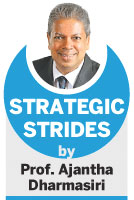Today’s column is an attempt to reflect on strategy formulation and execution in the Sri Lankan context.
 A game plan cannot be conceived or commissioned without people. In any organisation, we have physical, financial and information resources. The three resources are of no use if you do not have the most precious resource, the people. That is exactly why, people, to be precise, the ‘right’ people are the most precious asset to any forward-looking organisation.
A game plan cannot be conceived or commissioned without people. In any organisation, we have physical, financial and information resources. The three resources are of no use if you do not have the most precious resource, the people. That is exactly why, people, to be precise, the ‘right’ people are the most precious asset to any forward-looking organisation.
How to acquire, retain, develop, and engage them have become increasingly challenging with the growing complexity associated with doing business in a globalised world. Hence, managing human resources has become a critical factor for organisational success.
Living strategy with people
“If ‘people are our greatest assets, it’s time to make strategies that people can live in”, so says Prof. Lynda Gratton of the London Business School, in her much-acclaimed book, Living Strategy. “People are our most important asset.” “We are a knowledge-based company.” “All we have is our people.” These are statements that we hear even more frequently from companies.
Yet, to many of the people who populate our companies, the reality of organisational life is that people do not feel they are treated as the most important assets and they do not feel their knowledge is understood or used. As Prof. Gratton emphasises, it is time we kept human capital where it really deserves to be.
“The only route to improved performance is by placing human resources at the centre of your strategic decision-making”, argues Linda. Living Strategy shows you why and how to design strategies that have meaning and purpose for people, without whose commitment they remain drawings on the board-room wall chart. She suggests that a new management agenda is crucial and shares the three tenets of human organisational behaviour.
For corporate strategy to live and work, people have to understand strategy, and strategy makers have to understand people. Prof. Lynda Gratton stresses the need to be aware of the ‘why’ and ‘how’ of putting people at the heart of corporate strategy. If companies want to increase their business performance, they need to recognise and develop the soul of the organisation.
How has Hewlett-Packard sustained 20 per cent annual growth over a ten-year period, or how did GlaxoWellcome bring its products to the marketplace quicker by achieving significant reductions in its product development cycle or Motorola keep its growth rate buoyant in China?
Prof. Gratton raises a pertinent question. These are examples from across the globe but united by a common thread. If we had asked a similar question from the companies in 1900, the answer would have been that these companies achieve success because they have the financial capital to expand into new and emerging markets.
In the fifties, we could have spoken of their technological advantages, of the patents they held and exploited. But in 2000, at a time when raising $1 million is a nanosecond away, when patents erode in months, the advantages of the past have little meaning. The new sources of sustainable competitive advantage available to organisations have people at the centre – their creativity and talent, their inspirations and hopes, their dreams and excitement. The companies that flourish in this decade will do so because they are able to provide meaning and purpose, a context and frame that encourages individual potential to flourish and grow.
“For some of us the idea that people are at the very centre of successful organisations is an overriding passion, for others it is something we feel deep down, at an intuitive level, or perhaps we believe that people are peripheral to success”, observes Prof. Gratton. “Over the years I have become increasingly aware that it is people who make great companies.” She further states that with this awareness has come a growing realisation that by putting people at the heart of corporate strategy we must acknowledge the very humanness of this resource.
Whither Sri Lankan Managers?
Strategy formulation and execution should be confidently handled by competent people. The choice of connections over the competencies has been a perennial issue in the local arena, particularly in the public sector.
There was a time when the kith and kin of those who are at the helm appeared to be the favourites, with regard to filling the key positions. Has that custom really changed with the regime changes? Or has one set of loyalists have been replaced by another set of loyalists with same basis as the selection criteria? Is it a case of consolidating power in offering powerful positions to favouites irrespective of their potential to perform? Such questions pose several points to ponder.
It is pertinent to mention what David Oglivy, the advertising tycoon, had to say with respect to hiring: “If each of us hires people who are smaller than we are, we shall become a company of dwarfs, but if each of us hires people who are bigger than we are, we will become a company of giants”. In order to hire people with potential, the hiring process has to be professionally designed and executed. This is true for the private and public sectors.
Way forward
Sri Lankan organisations need to pay more attention to employ and engage people so that people ‘live the strategy’. Emphasis on processes and profit is fine but the fundamental focus should not be drifted away from people. Engaging employees with enhanced expertise should be the expected way towards excellence.
